Planet Dinosaur – Last Killers
Dasplatosaurus, Tyrannosaurus
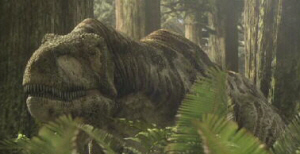
Daspletosaurus
In this episode, we explore the last generation of killer dinosaurs,
carnivores that took killing to a new level. At the end of the cretaceous period,
75 million years ago, these hunter/killers had spread throughout the globe.
In southern continents it was the powerful and muscular abelisaurus that
reigned supreme , in the north it was the famous tyrannosaur that dominated.
In 2009, medical scanners were used to look inside the brain cases of the killers. Of all the
dinosaur groups, tyrannosaurs where discovered to have one of the
largest areas devoted to smell, something that would give them a clear
hunting advantage.
Back then, cretaceous Alberta was a vast coastal river plain covered
in forests. The perfect hunting ground for daspletosaurus. At 9 metres
and 3 tons it’s the dominant predator in these forests. Here it relies
in its acute sense of smell as much as sight to hunt its prey.
Chasmosaurus, rhino-sized behemoth, bristling with defensive horns
makes an opponent befitting a killer like dasplatisaurus.
Of all the tyrannoausr, T. Rex might be the most famous, but the
evolutionary blue-print for these predators is laid down 10 million
years earlier with daspletosaurus. Tyrannosaurs effectiveness as killers
is clear from their anatomy.
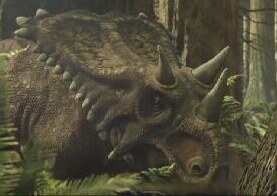
Chasmosaurus
They’re massive, with huge strong skulls
and powerful muscular necks. Forward facing eyes makes tracking moving
prey easy. They have, famously, short arms but with those giant
tyrannosaurs its all about the bite.
They had the most powerful bite of any dinosaur with teeth, unlike
the thin flesh-tearing blades of carnosaurs, are thick and strong easily
able to crush bone and kill.
Tyrannosaurs appeared, locked in an evolutionary arms-race, with the
horned dinosaurs. As one got bigger so did the other. Its a
predator/prey relationship that’s endured for more than 65 million
years.
Most striking are the head frills of the horned dinosaurs. The
imposing frill of chasmosaurus is actually made of thin bone and
wouldn’t stop the bite of a tyrannosaur. But, by making it look much
bigger, it had the desired effect. The horns and fills of the dinosaurs
acted as visual deterrents even if they offered little physical
protection. It meant that a full-grown chasmosaurus would usuall be safe
from most predators.
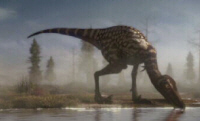
Edmontosaurus
In 2005, a remarkable discovery was announced. In The Two Medicine
Formation in Montana, a new dig had unearthed something quite extraordinary,
a collection of daspletosaurus fossils, all buried at the same place at
the same time. The implication is that daspletosaurus hunted in gangs. Tyrannosaurs,
like daspletosaurus, were so successful that by the late cretaceous they
were the apex predators across, virtually, all of North America and
Asia. In Asia there was alectrosaurus, alioramus and tarbosaurus. In
America there was albertosaurus, gorgosaurus daspletosaurus and T. Rex.
Moving further north, evidence of tyrannosaur becomes increasingly
rare. In Liscomb, Alaska fossils have been excavated close to the Arctic
Ocean. Its the richest source of dinosaur that lived in the polar
regions and it seems that here a different kind of killer dominated. The
most common plant-eater in this region is the edmontosaurus. They’re the
largest duck-billed dinosaur in North America and they are the perfect
prey for a different predator.
Troodon may not look as lethal as a tyrannosaur, but fossil evidence
suggests that these too were deadly hunters surviving entirely on a diet of
meat.
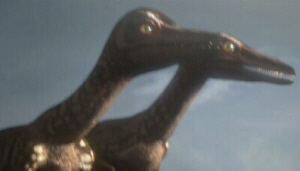
Troodon
At first sight, it appears that the adult edmontosaurus has little to
fear. 12 metres long and weighing 3,5 tons they physically dwarf this diminutive
predator. Troodon were usually small 2 metre dinosaurs, but the teeth from
the Alaska Troodon show that these arctic predators were almost twice as big
as normal. Troodon not only survived here, they positively thrived because
their hunting prowess comes into its own after sunset.
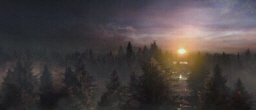
Alaskan Sunset
This is a land where, after late summer, there are more hours of darkness
than light. Troodon, famously, have the largest brain relative to their body
size of any dinosaur. Although, what appears to be more important are their
eyes. Not only are they forward-facing making them active hunters, they are
exceptionally large. These are predators that hunt equally well after dark.
The Alaska bone beds are dominated by juvenile edmontosaurus remains.
It seems that despite its small size, troodon thrived here by exploiting
the vulnerabilities of the juveniles throughout the long dark winter
months. Tyrannosaurs domination of the globe might have been total had
it not been for a quirk in the arrangement of the continents.
75 million years ago, the planet had a clear north/south divide, with no
physical link. Here a different kind of killer that reigned supreme, these
were abelisaurids. In the last 10 years, Madagascar has provided the most
comprehensive evidence about the predators.
70 million years ago, Madagascar was already an island, but its
climate was much hotter and drier than today. In the Cretaceous Period,
Madagascar was subject to devastating droughts and big predators like
Majungasaurus are especially vulnerable to starvation. Scavenging was
the only way to survive.
We thought Majungasaurus was the top predator here, but in 2003 some
bones of Majungasaurus were found gouged with teeth marks. It appeared
there was a bigger more brutal killer at large.
The shape of Majungasaurus skull and teeth suggest a very different
biting style to the flesh-tearing dinosaurs. With a broad short and
muscular skull it was a dino better adapted to biting and gripping
rather than slashing its prey,
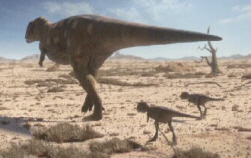
Majungasaurus
When the bite marks on the mauled Majungasaurus were studied more
closely, the marks on the bone were found to match the only large
carnivore in the region – Majungasaurus, This is the first irrefutable
evidence of dinosaur cannibalism. It might seem shocking, but its a
behaviour that clearly shows the most successful killers will exploit any
situation for the maximum advantage.
Daspletosaurus, with a bite-force unmatched by any dinosaur, have congregated in
a large group to take advantage of an annual event.
In Dinosaur Provincial Park, thousands of bones have been discovered scattered
across the same rock layer. They belong to the horned dinosaur
Centrosaurus. They appear to be the bone-beds of vast killing fields,
sites of wholesale slaughter.
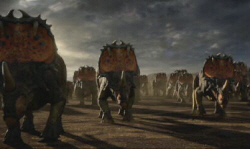
Centroaurus
A vast herd of Centrosaurus are on the
move from their nesting sites on the coastal lowlands. Unwittingly,
they’re moving towards almost certain death.
Seasonal monsoons drive
the Centrosaurs inland away from coastal flooding. Its what the
Daspletosaurus have been waiting for. Herding behaviour protects the
many at the expense of the few. Despite the rich-pickings Daspletosaurus
are not responsible for the wholesale slaughter, Daspletosaurus attack
and kill the Centrosaurus and in doing so, stampede the herd. The
Centrosaurus are driven into monsoon swollen rivers and drowned.
In
recent studies of the dense bone-bed indicate that 96% of the bones are
of a single species and relatively few display any bite marks. The
fossil evidence suggests that was a mass drowing, an evevy we’ve seen in
over 20 sites.






